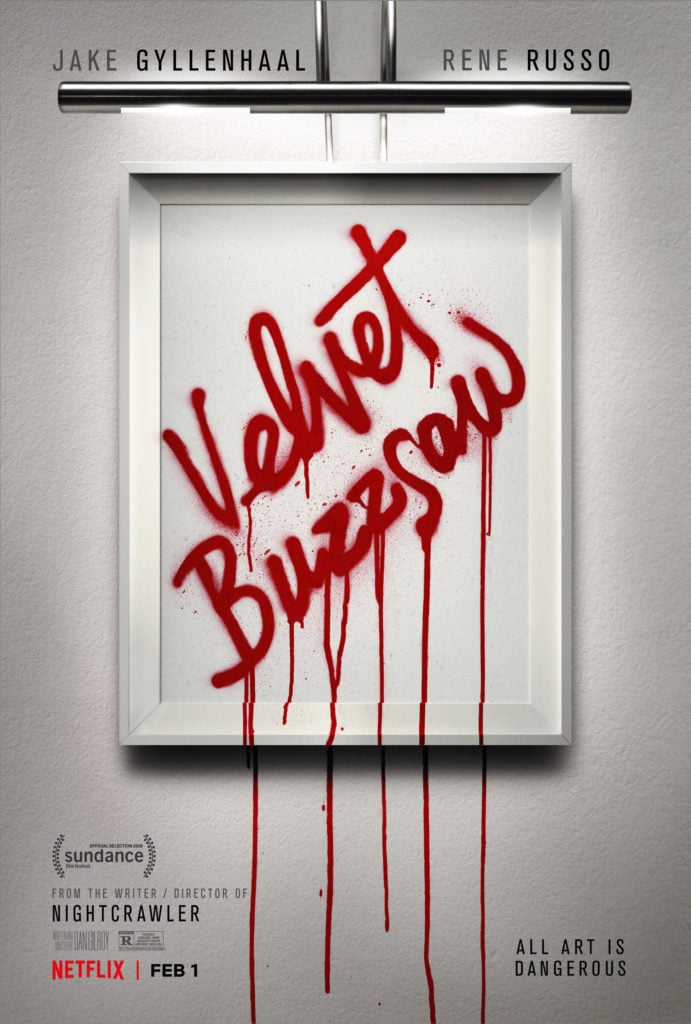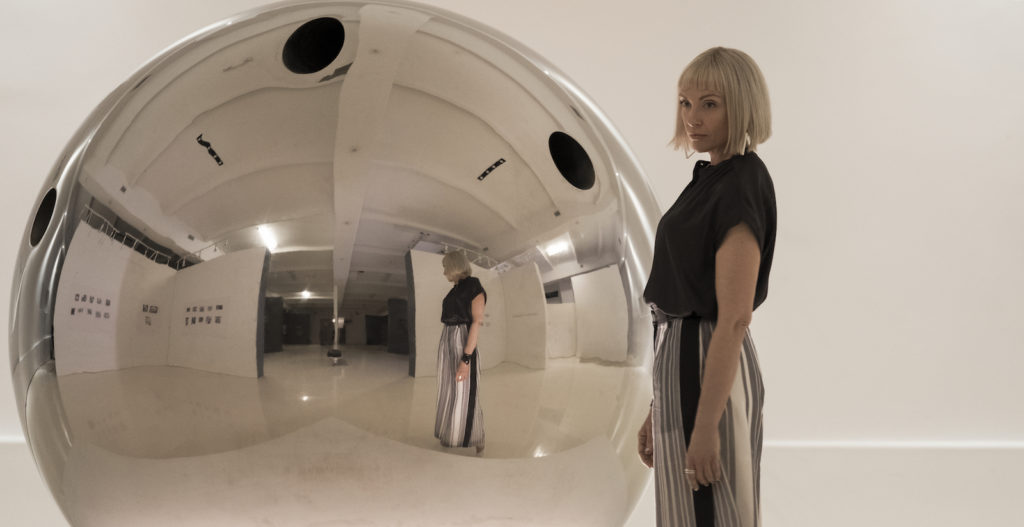Velvet Buzzsaw, launching on Netflix tomorrow, had me hooked from the first line uttered by its protagonist. In the opening scene, we see Jake Gyllenhaal’s stridently self-confident art critic amble into Art Basel Miami Beach. He passes the throngs of visitors trying to jump the line. Then he announces himself at the VIP desk: “Morf Vanderwalt, Artweb.”
Written and directed by Dan Gilroy (Nightcrawler), Velvet Buzzsaw is an “art horror” film that really stresses the art part. It stars the spookiest haunted paintings this side of … I don’t know, the diabolical possessed portrait of Vigo the Carpathian in Ghostbusters II? (I’m going to try not to spoil too much here that isn’t in the trailer – but just so you know, this is definitely a movie whose trailer gives way, way too much away. The optimum experience is to stream the ‘Saw knowing nothing.) The basic setup turns on the relationships and rivalries between Gyllenhaal’s art critic and a cast of characters including sharkish art dealer Rhodora Haze (Rene Russo); Josephina, a put-upon but ambitious partner in Russo’s Haze Gallery (Zawe Ashton); and sundry other gallerists, curators, and artists. Looking for her big break, Josephina discovers a trove of spooky paintings in the apartment of her dead neighbor, the mysterious Vitril Dease, which mesmerize all who see them. And, well, soon people under the spell of the evil art start to die.
Honestly, this is the way you should make a movie about art: Let the art world’s general daffiness serve as a setting for some kind of genre tale, rather than focusing just on surveying the daffiness. However, it must be said that Velvet Buzzsaw is more fun as a satire of art than it is as a horror movie. It follows basic horror-movie logic where sinister forces function as a kind of moral reckoning, punishing the characters for their sins. It’s just that here, instead of those sins being something like having your boyfriend over while your parents are away, they involve faking the chain of title on an artist’s estate or strong-arming a museum into showing a patron’s favorite artist.
In promotional notes for the film, Gilroy has said that he was inspired to write Velvet Buzzsaw after a trip to Dia: Beacon. “I wound up in the basement in a video installation with, like, dentist chairs and rats running around,” he says. “And I just thought, ‘Man, this would be a great place for a horror movie’.” (Gilroy is probably talking about the Bruce Nauman’s Mapping the Studio I (Fat Chance John Cage), from 2001.)
You can see why Gilroy went with the clearly Henry Darger-inspired conception for Vitril Dease instead. The idea of a mysterious outsider artist better fits the demands of horror-movie convention. And the film’s other conceit—that Dease’s art is immediately recognized by all who see it as more real and raw than the faddish art-fair spectacle that otherwise preoccupies them – requires a painter. (At one point, Morf is pictured blogging about Art Basel Miami Beach: “Star of the Nova section was Mertilla Splude’s Go-Pro Kindergarten, an inspired disquisition of early age experience …”) Painting is, in the public mind, more “real” than video art, for sure.

Poster for Velvet Buzzsaw. Image courtesy Netflix.
But you kind of wish that the filmmakers would have kept faith with the original inspiration. In the end, the imagery of Dease’s art – spooky children, evil monkeys, haunted dolls – is just a little too much stock horror shtick to stick deeply in the brain. The best kills in the film are the “artiest” – and none of the scares will be quite scary or gruesome enough for die-hard horror aficionados.
On the other hand … as a fairly angry satire of the art industry in 2019, the horror set-up of Velvet Buzzsaw is a fine delivery system. This is a horror movie about money and the commercialization of art in the same way that Get Out was a horror movie about gaslighting and liberal racism. (“Vitril Dease,” incidentally, is an anagram of “Devil Satire.”)
From that perspective, the film is a real gas, with a better-than-average collection of riffs on art’s excesses and pretensions – and not just moments like when Morf rebuffs an art dealer in Miami who is trying to convince him of the significance of a sculpture of a sad animatronic hobo with the immortal line, “Wolfson. Female Figure. Four years ago.” Burn!

An animatronic work of art (Mark Steger) in Velvet Buzzsaw (2019). Image courtesy Netflix.
The scene where an art installer/artist (Billy Magnussen) mansplains how to pronounce the “Broad” in Broad Museum to a much-abused 22-year-old gallery assistant (Natalia Dyer)? Funny. Russo’s Rhodora Haze forcing collectors who want work by her sensation of the moment – Dease – to buy three paintings to support the market of a fading star (John Malkovich)? Nicely observed. A brash curator, Gretchen (Toni Collette), gleefully ejecting herself from her museum job to become an art adviser? That does pretty much sum up the balance of forces between stretched-thin nonprofits and private wealth today. (Depicted as being across the street from the Broad, the LAMA museum is clearly meant as LA MOCA – though Gretchen makes a crack about how she won’t miss “Tuesday meatloaf at the café overlooking the Tar Pits,” which is LACMA.)

Gretchen (Toni Collette) in Velvet Buzzsaw. Image courtesy Netflix.
“I came to the museum because I wanted to change the world through art, but the wealthy vacuum up everything, except the crumbs,” Collette’s curator tells Gyllenhaal’s critic excitedly. “The best work is only enjoyed by a tiny few, and they buy what they are told, so why not join the party?”
“It’s everywhere, the money question,” Morf replies solemnly. Hilarious.
If there is a main false note here, it is in the figure of the art critic (and yes, I know, it’s no surprise that I would say this). I do love the conviction with which Gyllenhaal’s critic drops great art-critic lines like, “I am ensorcelled” and “it’s mesmeric.” But at one moment he’ll snap something decisively crass like, “I’m posting a review – how much is it?” At another, he will defend the purity of his craft with beautiful naiveté: “This is my life. How I connect with some sort of spirituality and actual present. I assess out of adoration. I further the realm I analyze.” Maybe the double consciousness is part of the satire? Either way, the really unrealistic thing is how much sheer clout the art critic wields in this particular parallel art universe, putting him on the same power plane as all the other players, with a huge sense of his king-making power to match. And an improbably excellent car.
What is least authentic about the art-fair scenes, to an art writer’s eye, is how excited to see the writer the dealers are – with nary a hint of looking over his shoulder for the really important people, the collectors. “In our world, you are god,” Haze coos to Vanderwalt at one point.
Now that I mention it, if the figure of the critic has a slightly over-inflated status here, the figure of the super-rich collector – the prime mover of the present-day art industry – is surprisingly peripheral. (Collette’s art advisor is the main proxy for the more-money-than-taste set.) For a satire of the venality of the present-day art industry, that’s an odd mirror-image reversal of reality. One of the most-commented-upon features of art’s industrial-strength commercialization is that the unmediated appetites of dumb wealth and fickle finance have replaced both connoisseurship and critique. Criticism’s not dead – but it doesn’t exactly command the indispensable commercial “stamp of approval” power that the film ascribes to the dapper writer from Artweb here.
I mean, this is a world that thinks that what the critic does is so powerful that there is a scene – not to give too much away – where Gyllenhaal’s Morf is literally haunted by all the bad reviews that he has written.
It’s funny – Velvet Buzzsaw is a horror movie and a jaded take-down, and on many levels very bleak and cutting, but on this level it is actually almost comfortingly nostalgic and unintentionally flattering. I am ensorcelled.
This piece was originally published in artnet News, one of our partners.



























